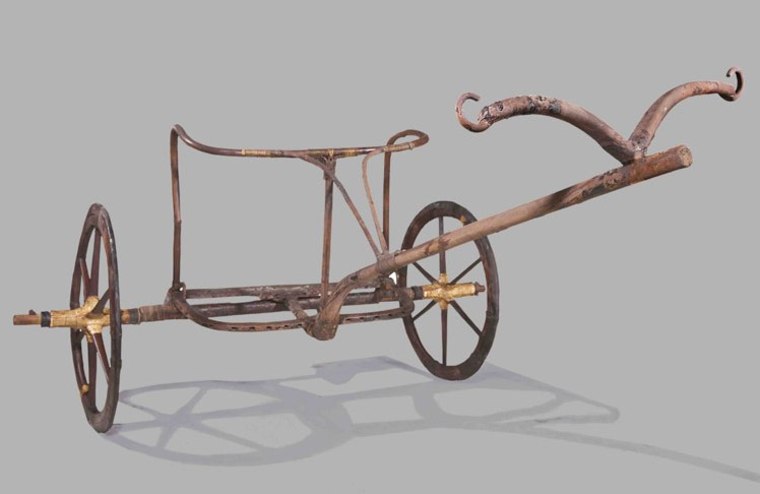King Tutankhamun, the pharaoh who ruled Egypt more than 3,300 years ago, rode full speed over the desert dunes on a Formula One-like chariot, according to new investigations into the technical features of the boy king's vehicle collection.
Discovered in pieces by British archaeologist Howard Carter when he entered King Tut's treasure-packed tomb in 1922, the collection consisted of two large ceremonial chariots, a smaller highly decorated one, and three others that were lighter and made for daily use.
"They were the Ferrari of antiquity. They boasted an elegant design and an extremely sophisticated and astonishingly modern technology," Alberto Rovetta, professor in robotics engineering at the Polytechnic of Milan, told Discovery News.
Of the six chariots, one made its longest ride yet last week when it traveled outside Egypt for the first time in three millennia to the "Tutankhamun and the Golden Age of the Pharaohs" exhibit in New York's Discovery Times Square Exposition.
"My feeling is that this is the chariot the king actually did use in his war and hunting rides. It is smaller, much lighter, much faster and lacks in decoration. One tire is extremely worn, the other is newer. You don't replace things unless you expect to re-use them," David Silverman, curator of the exhibition, told Discovery News.
The chariot, which is usually on display at Luxor museum, represents the high level of engineering sophistication reached by the Egyptian chariot builders at King Tut's time, according to Rovetta.
"These vehicles appear to be the first mechanical systems which combine the use of kinematics, dynamics and lubrication principles," Rovetta said.
Further studies, in collaboration with Nasry Iskander at the conservation department of the Egyptian Museum in Cairo, showed the unique interplay of form and function in King Tut's chariots. These technical underpinnings involve the design of the wheels, the naves, the bearings, and the pole between the cart and the yoke.
"The wheels feature a real tire, made of a flexible wood rim, which adapts to soil irregularities. Moreover, the six-spoke wheels are made from elastic wood. This absorbs uniformly the loads transmitted by soil irregularity, so that the vibrations are damped by the wheel itself like the intelligent suspensions in modern cars," Rovetta said.
The result is a remarkable level of softness and comfort. Even at speeds of about 25 miles per hour on Egypt's irregular soil, King Tut's chariots were efficient and pleasant to ride.
But there was more.
"The bearings are built exploiting the modern principle of a hard material against a soft material and by applying animal grease between the surfaces. The grease reduces friction and increases running duration," Rovetta said.
According to Bela Sandor, professor emeritus of engineering physics at University of Wisconsin at Madison, King Tut's chariots surpass all monumental structures of the pharaohs in engineering sophistication.
"There is no evidence of chariot racing from that era, but these chariots have many technical features that imply a pedigree based on racing," Sandor said.
In a study on the chariots' engineering, Sandor concluded that the vehicles were the earliest high-performance machines, boasting a complex suspension system of springs and shock absorbers. They even featured wheels with aircraft-like damage tolerance.
Such a focus on comfort and safety may cast doubt on the theory that King Tut's leg fracture, which occurred a few hours before he died according to recent CT scans, was caused by a fall from the fast moving chariot.
"There is a 50-50 chance that he fell right from the chariot on display in New York," Silverman said.
Recent analysis has shown that King Tut had a malformation in his left foot and suffered from malaria.
"If he was riding with these problems, he might have not been able to keep stable and might have fallen. It wasn't the chariot's fault. Indeed, this story is amazing when you to think that the chariot was introduced to Egypt by the Hyksos. It did not take Egypt long — just two generations —to have the world's best chariots," Silverman said.
